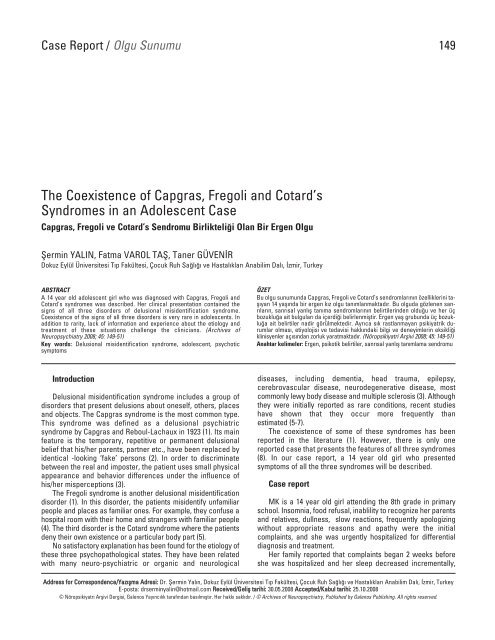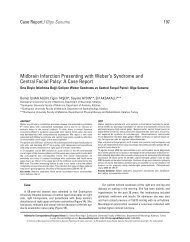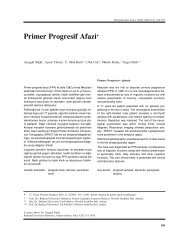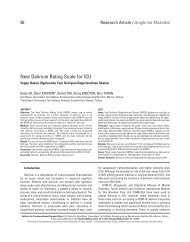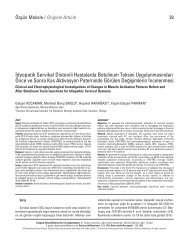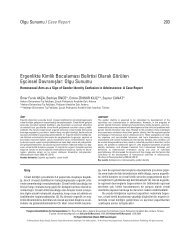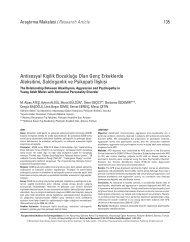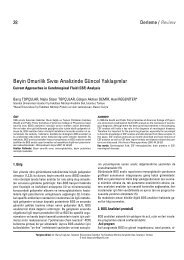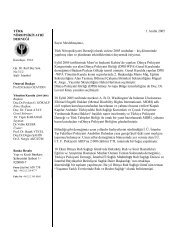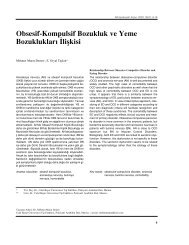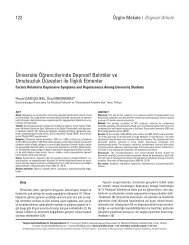The Coexistence of Capgras, Fregoli and Cotard's Syndromes in an ...
The Coexistence of Capgras, Fregoli and Cotard's Syndromes in an ...
The Coexistence of Capgras, Fregoli and Cotard's Syndromes in an ...
You also want an ePaper? Increase the reach of your titles
YUMPU automatically turns print PDFs into web optimized ePapers that Google loves.
Case Report / Olgu Sunumu 149<strong>The</strong> <strong>Coexistence</strong> <strong>of</strong> <strong>Capgras</strong>, <strong>Fregoli</strong> <strong><strong>an</strong>d</strong> Cotard’s<strong>Syndromes</strong> <strong>in</strong> <strong>an</strong> Adolescent Case<strong>Capgras</strong>, <strong>Fregoli</strong> ve Cotard’s Sendromu Birlikteli¤i Ol<strong>an</strong> Bir Ergen Olgufierm<strong>in</strong> YALIN, Fatma VAROL TAfi, T<strong>an</strong>er GÜVEN‹RDokuz Eylül Üniversitesi T›p Fakültesi, Çocuk Ruh Sa¤l›¤› ve Hastal›klar› Anabilim Dal›, ‹zmir, TurkeyABSTRACTA 14 year old adolescent girl who was diagnosed with <strong>Capgras</strong>, <strong>Fregoli</strong> <strong><strong>an</strong>d</strong><strong>Cotard's</strong> syndromes was described. Her cl<strong>in</strong>ical presentation conta<strong>in</strong>ed thesigns <strong>of</strong> all three disorders <strong>of</strong> delusional misidentification syndrome.<strong>Coexistence</strong> <strong>of</strong> the signs <strong>of</strong> all three disorders is very rare <strong>in</strong> adolescents. Inaddition to rarity, lack <strong>of</strong> <strong>in</strong>formation <strong><strong>an</strong>d</strong> experience about the etiology <strong><strong>an</strong>d</strong>treatment <strong>of</strong> these situations challenge the cl<strong>in</strong>ici<strong>an</strong>s. (Archives <strong>of</strong>Neuropsychiatry 2008; 45: 149-51)Key words: Delusional misidentification syndrome, adolescent, psychoticsymptomsÖZETBu olgu sunumunda <strong>Capgras</strong>, <strong>Fregoli</strong> ve Cotard’s sendromlar›n›n özellikler<strong>in</strong>i tafl›y<strong>an</strong>14 yafl›nda bir ergen k›z olgu t<strong>an</strong>›ml<strong>an</strong>maktad›r. Bu olguda gözlenen s<strong>an</strong>r›lar›n,s<strong>an</strong>r›sal y<strong>an</strong>l›fl t<strong>an</strong>›ma sendromlar›n›n belirtiler<strong>in</strong>den oldu¤u ve her üçbozuklu¤a ait bulgular› da içerdi¤i belirlenmifltir. Ergen yafl grubunda üç bozuklu¤aait belirtiler nadir görülmektedir. Ayr›ca s›k rastl<strong>an</strong>may<strong>an</strong> psikiyatrik durumlarolmas›, etiyolojisi ve tedavisi hakk›ndaki bilgi ve deneyimler<strong>in</strong> eksikli¤ikl<strong>in</strong>isyenler aç›s›nd<strong>an</strong> zorluk yaratmaktad›r. (Nöropsikiyatri Arflivi 2008; 45: 149-51)Anahtar kelimeler: Ergen, psikotik belirtiler, s<strong>an</strong>r›sal y<strong>an</strong>l›fl t<strong>an</strong>›mlama sendromuIntroductionDelusional misidentification syndrome <strong>in</strong>cludes a group <strong>of</strong>disorders that present delusions about oneself, others, places<strong><strong>an</strong>d</strong> objects. <strong>The</strong> <strong>Capgras</strong> syndrome is the most common type.This syndrome was def<strong>in</strong>ed as a delusional psychiatricsyndrome by <strong>Capgras</strong> <strong><strong>an</strong>d</strong> Reboul-Lachaux <strong>in</strong> 1923 (1). Its ma<strong>in</strong>feature is the temporary, repetitive or perm<strong>an</strong>ent delusionalbelief that his/her parents, partner etc., have been replaced byidentical -look<strong>in</strong>g ‘fake’ persons (2). In order to discrim<strong>in</strong>atebetween the real <strong><strong>an</strong>d</strong> imposter, the patient uses small physicalappear<strong>an</strong>ce <strong><strong>an</strong>d</strong> behavior differences under the <strong>in</strong>fluence <strong>of</strong>his/her misperceptions (3).<strong>The</strong> <strong>Fregoli</strong> syndrome is <strong>an</strong>other delusional misidentificationdisorder (1). In this disorder, the patients misidentify unfamiliarpeople <strong><strong>an</strong>d</strong> places as familiar ones. For example, they confuse ahospital room with their home <strong><strong>an</strong>d</strong> str<strong>an</strong>gers with familiar people(4). <strong>The</strong> third disorder is the Cotard syndrome where the patientsdeny their own existence or a particular body part (5).No satisfactory expl<strong>an</strong>ation has been found for the etiology <strong>of</strong>these three psychopathological states. <strong>The</strong>y have been relatedwith m<strong>an</strong>y neuro-psychiatric or org<strong>an</strong>ic <strong><strong>an</strong>d</strong> neurologicaldiseases, <strong>in</strong>clud<strong>in</strong>g dementia, head trauma, epilepsy,cerebrovascular disease, neurodegenerative disease, mostcommonly lewy body disease <strong><strong>an</strong>d</strong> multiple sclerosis (3). Althoughthey were <strong>in</strong>itially reported as rare conditions, recent studieshave shown that they occur more frequently th<strong>an</strong>estimated (5-7).<strong>The</strong> coexistence <strong>of</strong> some <strong>of</strong> these syndromes has beenreported <strong>in</strong> the literature (1). However, there is only onereported case that presents the features <strong>of</strong> all three syndromes(8). In our case report, a 14 year old girl who presentedsymptoms <strong>of</strong> all the three syndromes will be described.Case reportMK is a 14 year old girl attend<strong>in</strong>g the 8th grade <strong>in</strong> primaryschool. Insomnia, food refusal, <strong>in</strong>ablility to recognize her parents<strong><strong>an</strong>d</strong> relatives, dullness, slow reactions, frequently apologiz<strong>in</strong>gwithout appropriate reasons <strong><strong>an</strong>d</strong> apathy were the <strong>in</strong>itialcompla<strong>in</strong>ts, <strong><strong>an</strong>d</strong> she was urgently hospitalized for differentialdiagnosis <strong><strong>an</strong>d</strong> treatment.Her family reported that compla<strong>in</strong>ts beg<strong>an</strong> 2 weeks beforeshe was hospitalized <strong><strong>an</strong>d</strong> her sleep decreased <strong>in</strong>crementally,Address for Correspondence/Yaz›flma Adresi: Dr. fierm<strong>in</strong> Yal›n, Dokuz Eylül Üniversitesi T›p Fakültesi, Çocuk Ruh Sa¤l›¤› ve Hastal›klar› Anabilim Dal›, ‹zmir, TurkeyE-posta: drserm<strong>in</strong>yal<strong>in</strong>@hotmail.com Received/Gelifl tarihi: 30.05.2008 Accepted/Kabul tarihi: 25.10.2008© Nöropsikiyatri Arflivi Dergisi, Galenos Yay›nc›l›k taraf›nd<strong>an</strong> bas›lm›flt›r. Her hakk› sakl›d›r. / © Archives <strong>of</strong> Neuropsychiatry, Published by Galenos Publish<strong>in</strong>g. All rights reserved.
150Yal›n et al.<strong>The</strong> <strong>Coexistence</strong> <strong>of</strong> <strong>Capgras</strong>, <strong>Fregoli</strong> <strong><strong>an</strong>d</strong> Cotard’s <strong>Syndromes</strong> <strong>in</strong> <strong>an</strong> Adolescent CaseArchives <strong>of</strong> Neuropsychiatry 2008; 45: 149-51Nöropsikiyatri Arflivi 2008; 45: 149-51she had not slept for the previous 2-3 days <strong><strong>an</strong>d</strong> staredme<strong>an</strong><strong>in</strong>glessly. She refused to eat, did not permit her parents toeat, had exaggerated fears, had thoughts that her parents <strong><strong>an</strong>d</strong>herself would be harmed, didn't recognize her parents <strong>in</strong> theprevious 2-3 days, w<strong>an</strong>ted to go to her ‘real’ parents, thought thatstr<strong>an</strong>gers had replaced her parents <strong><strong>an</strong>d</strong> would not cooperate.She had not had similar compla<strong>in</strong>ts <strong>in</strong> the past, but dur<strong>in</strong>g theprevious 3 months she had been worry<strong>in</strong>g about her academicperform<strong>an</strong>ce <strong>in</strong> the high school entr<strong>an</strong>ce exam. <strong>The</strong>re were noproblems reported <strong>in</strong> her family <strong><strong>an</strong>d</strong> peer relations, she was alsodo<strong>in</strong>g well academically at school.In the <strong>in</strong>itial evaluation for the mental status exam, she had afearful face <strong><strong>an</strong>d</strong> was not communicat<strong>in</strong>g verbally. Her affect wasdull <strong><strong>an</strong>d</strong> her mood was reported as very <strong>an</strong>xious. Her attentionperiod was very short <strong><strong>an</strong>d</strong> her orientation, judgment <strong><strong>an</strong>d</strong> realitytest<strong>in</strong>g were impaired. She was suffer<strong>in</strong>g from par<strong>an</strong>oidpersecutiondelusions <strong><strong>an</strong>d</strong> she also had a derealization <strong><strong>an</strong>d</strong>depersonalization thought context. Additionally, her thoughtprocess <strong><strong>an</strong>d</strong> psychomotor activities were retarded.In order to differentiate the diagnosis, biochemical <strong><strong>an</strong>d</strong>endocr<strong>in</strong>ological tests, electroencephalography (EEG),computerized bra<strong>in</strong> tomography (CBT), magnetic reson<strong>an</strong>ceimag<strong>in</strong>g <strong>of</strong> bra<strong>in</strong> (MRI) <strong><strong>an</strong>d</strong> pediatric neurology consultationswere carried out. <strong>The</strong>re were no abnormalities reported <strong>in</strong> theneurological exam<strong>in</strong>ation or laboratory tests. Dur<strong>in</strong>g thepatient’s stay <strong>in</strong> our unit, the most remarkable sign was her<strong>in</strong>ability to recognize her parents <strong><strong>an</strong>d</strong> her delusional thoughtsthat they were not her real parents. When she was with herparents, she thought that they were doubles or fakes who hadreplaced her real parents. However, when she was on thephone with them, she did not express <strong>an</strong>y suspicions aboutthem. She had delusional thoughts with a persecutory context,such as the hospital was not a real one, the medical team werenot hospital staff, everyth<strong>in</strong>g was a play <strong>in</strong> which she wouldeventually be harmed. She also had reference delusions thatpeople were talk<strong>in</strong>g about <strong><strong>an</strong>d</strong> laugh<strong>in</strong>g at her. In addition, shehad more delusional thoughts such as that she knew some <strong>of</strong>the patients <strong>in</strong> the unit <strong><strong>an</strong>d</strong> members <strong>of</strong> the team, <strong><strong>an</strong>d</strong> thatactually she was dead <strong><strong>an</strong>d</strong> her soul was w<strong><strong>an</strong>d</strong>er<strong>in</strong>g aroundwait<strong>in</strong>g to be punished. Due to her mother’s pregn<strong>an</strong>cy thepatient was over-<strong>an</strong>xious about her health.Hav<strong>in</strong>g excluded the org<strong>an</strong>ic etiology, risperidonetreatment with 2 mg per day was begun <strong><strong>an</strong>d</strong> the daily dosegradually <strong>in</strong>creased to 6mg/day. As there was no positivetreatment response to 6mg/day risperidone after 3 weeks, thiswas replaced with <strong>an</strong>other atypical <strong>an</strong>tipsychotic, ol<strong>an</strong>zap<strong>in</strong>e.Despite the fact that psychotic symptoms dim<strong>in</strong>ished, a cl<strong>in</strong>icalm<strong>an</strong>ic shift appeared. Valproate was added to the treatmentwhen the m<strong>an</strong>ic state <strong>of</strong> the patient gradually becamem<strong>an</strong>ifest after commenc<strong>in</strong>g ol<strong>an</strong>zap<strong>in</strong>e. Follow<strong>in</strong>g the addition<strong>of</strong> valproate, ol<strong>an</strong>zap<strong>in</strong>e was decreased while quetiap<strong>in</strong>etreatment was started <strong><strong>an</strong>d</strong> the quetiap<strong>in</strong>e dose was gradually<strong>in</strong>creased to 1500 mg per day. On discont<strong>in</strong>u<strong>in</strong>g ol<strong>an</strong>zap<strong>in</strong>e, them<strong>an</strong>ic symptoms disappeared. In the process, the patient’spsychotic symptoms recovered signific<strong>an</strong>tly <strong><strong>an</strong>d</strong> eventually shewas discharged without <strong>an</strong>y symptoms.DiscussionDur<strong>in</strong>g the treatment period <strong>in</strong> the unit, it was observed thatour patient had symptoms <strong>of</strong> <strong>Capgras</strong>, Cotard <strong><strong>an</strong>d</strong> <strong>Fregoli</strong><strong>Syndromes</strong>. <strong>The</strong> ma<strong>in</strong> cl<strong>in</strong>ical characteristics <strong>of</strong> the <strong>Capgras</strong>syndrome is a delusional belief that familiar persons arereplaced by str<strong>an</strong>gers (2).<strong>The</strong> patient refers to some small,mis<strong>in</strong>terpreted physical <strong><strong>an</strong>d</strong> behavioral differences <strong>in</strong> her m<strong>in</strong>dto differentiate the familiar persons from str<strong>an</strong>gers (3). Whenpatients are questioned about their delusional ideas, they f<strong>in</strong>dthem unbelievable <strong><strong>an</strong>d</strong> weird, but these delusional thoughtscont<strong>in</strong>ue (2). <strong>The</strong> most dom<strong>in</strong><strong>an</strong>t delusional thought <strong>in</strong> our casewas that str<strong>an</strong>gers had taken the place <strong>of</strong> her parents. Shema<strong>in</strong>ta<strong>in</strong>ed that her visitors (real parents) looked the same as herparents, but their behavior <strong><strong>an</strong>d</strong> way <strong>of</strong> look<strong>in</strong>g were different <strong><strong>an</strong>d</strong>she <strong>in</strong>sisted on see<strong>in</strong>g her real parents.<strong>The</strong> Cotard syndrome is characterized by delusionalthoughts <strong>of</strong> deny<strong>in</strong>g one’s own existence or particular parts <strong>of</strong>his/her body (5, 9). In the literature, 89% <strong>of</strong> the cases haddepressive symptoms, 69% had nihilistic delusions about theirexistence, 65% had <strong>an</strong>xiety symptoms, <strong><strong>an</strong>d</strong> 63% had feel<strong>in</strong>gs <strong>of</strong>guilt (5). Our patient said that she had died <strong><strong>an</strong>d</strong> didn’t exist.Me<strong>an</strong>while, she thought this was all her fault <strong><strong>an</strong>d</strong> kept apologiz<strong>in</strong>g.She was suffer<strong>in</strong>g from signific<strong>an</strong>t <strong>an</strong>xiety regard<strong>in</strong>g herdelusional experiences <strong><strong>an</strong>d</strong> her mother’s state <strong>of</strong> health.In the <strong>Fregoli</strong> syndrome, patients have delusional beliefs thatthey know quite unfamiliar persons <strong><strong>an</strong>d</strong> places very well. <strong>The</strong>yc<strong>an</strong> perceive the hospital room as their home, or a str<strong>an</strong>ger astheir relative (4). Our case believed that some patients <strong>in</strong> the unitwere her parents <strong><strong>an</strong>d</strong> some <strong>of</strong> the staff were her relatives.Especially <strong>in</strong> the <strong>Capgras</strong> Syndrome, there are someadditional symptoms such as seen <strong>in</strong> our case. Par<strong>an</strong>oid ideas,derealization <strong><strong>an</strong>d</strong> depersonalization are the frequentdisturb<strong>an</strong>ces (1, 7). One study found 83% par<strong>an</strong>oid delusions <strong><strong>an</strong>d</strong>43% derealization <strong><strong>an</strong>d</strong> depersonalization <strong>in</strong> <strong>Capgras</strong> syndromecases (7).Although <strong>in</strong>itial studies found that these syndromes wererare, subsequent <strong>in</strong>vestigations showed that they were morefrequent. A study conducted <strong>in</strong> <strong>an</strong> acute psychiatric servicefound that the <strong>Capgras</strong> syndrome rate was 2.5% <strong><strong>an</strong>d</strong> <strong>in</strong> <strong>an</strong>otherstudy which evaluated the previous 5 years <strong>of</strong> patients’ records<strong>in</strong> a university hospital, the rate was 1.3% (6, 7). This syndromec<strong>an</strong> affect both genders at all ages (6). However, some authorsfound that it was more frequent <strong>in</strong> women (2).Berios et al reviewed the literature s<strong>in</strong>ce 1955 <strong><strong>an</strong>d</strong> reported100 Cotard syndrome cases. <strong>The</strong> average age <strong>of</strong> these caseswas 52 years <strong><strong>an</strong>d</strong> the youngest patient was 16 years (5). Asreported <strong>in</strong> the literature, the Cotard syndrome had a differentcl<strong>in</strong>ical course <strong>in</strong> young cases. Its frequency <strong><strong>an</strong>d</strong> relation withother disorders were not def<strong>in</strong>ite. It was reported that thesyndrome was more frequent <strong>in</strong> girls <strong><strong>an</strong>d</strong> the girl/boy ratio was12/7 (9). Mojtabei (1994) reviewed the literature <strong>in</strong> 1994 <strong><strong>an</strong>d</strong>reported 34 <strong>Fregoli</strong> syndrome cases. <strong>The</strong>ir average age was 34.9years <strong><strong>an</strong>d</strong> ma<strong>in</strong>ly male (4).<strong>The</strong>re has been no def<strong>in</strong>ite expl<strong>an</strong>ation about the etiology <strong>of</strong>all these psychopathological conditions. In the literature, the<strong>in</strong>itial studies regard<strong>in</strong>g the <strong>Capgras</strong> syndrome attributed the
Archives <strong>of</strong> Neuropsychiatry 2008; 45: 149-51Nöropsikiyatri Arflivi 2008; 45: 149-51Yal›n et al.<strong>The</strong> <strong>Coexistence</strong> <strong>of</strong> <strong>Capgras</strong>, <strong>Fregoli</strong> <strong><strong>an</strong>d</strong> Cotard’s <strong>Syndromes</strong> <strong>in</strong> <strong>an</strong> Adolescent Case 151causation psycho<strong>an</strong>alytically but subsequent authorsemphasized diffuse <strong><strong>an</strong>d</strong> localized bra<strong>in</strong> lesions, whereas someauthors reported the association <strong>of</strong> two different causations (10).In the literature 25-40% <strong>of</strong> the <strong>Capgras</strong> syndrome cases had <strong>an</strong>org<strong>an</strong>ic etiology. Bra<strong>in</strong> imag<strong>in</strong>g studies are essential <strong>in</strong> order toclarify the org<strong>an</strong>ic etiology. <strong>The</strong> lesion is more frequent <strong>in</strong> thefrontal, parietal <strong><strong>an</strong>d</strong> temporal lobes (2). In etiological studies <strong>of</strong>the Cotard syndrome, the disorder was found to be related withorg<strong>an</strong>ic mental disorders such as psychotic major depression,schizophrenia, epilepsy, encephalitis <strong><strong>an</strong>d</strong> pre-senility (9).Schizophrenia was the most frequent cause <strong>in</strong> the <strong>Fregoli</strong>Syndrome. Psychosis with <strong>an</strong> org<strong>an</strong>ic etiology, affectivedisorders <strong><strong>an</strong>d</strong> other psychotic disorders were also frequentco-morbidities (4). In our case, all <strong>in</strong>vestigations to determ<strong>in</strong>e <strong>an</strong>org<strong>an</strong>ic etiology were undertaken, but no pathology was found.Although the neurological exam<strong>in</strong>ation was normal, the EEGshowed non-specific abnormalities. <strong>The</strong>se abnormal signs couldbe <strong>in</strong>sufficient to expla<strong>in</strong> the symptoms <strong>of</strong> the patient but mightbecome very import<strong>an</strong>t dur<strong>in</strong>g the follow-up. In addition, it wasemphasized that there was a relation between org<strong>an</strong>ic causes<strong><strong>an</strong>d</strong> the age <strong>of</strong> the patient, <strong><strong>an</strong>d</strong> the age could be import<strong>an</strong>t fordeterm<strong>in</strong><strong>in</strong>g the etiology <strong>in</strong> the <strong>Capgras</strong> syndrome. An org<strong>an</strong>icetiology was found <strong>in</strong> 4 <strong>of</strong> 13 <strong>Capgras</strong> cases <strong>in</strong> a study with <strong>an</strong>average patient age <strong>of</strong> 33 years, <strong><strong>an</strong>d</strong> <strong>in</strong> <strong>an</strong>other study themajority <strong>of</strong> the <strong>Capgras</strong> patients with <strong>an</strong> average age <strong>of</strong> 56 yearshad <strong>an</strong> org<strong>an</strong>ic pathology. In view <strong>of</strong> the literature regard<strong>in</strong>g theonset age <strong>of</strong> the psychopathology, the probability <strong>of</strong> org<strong>an</strong>icetiology <strong>in</strong> our case is very low (7).Psychodynamic expl<strong>an</strong>ations <strong>of</strong> the orig<strong>in</strong>s <strong>of</strong> the <strong>Capgras</strong>syndrome consist <strong>of</strong> four basic groups; unresolved oedipalproblems <strong>in</strong> women, alienation <strong><strong>an</strong>d</strong> other affective problems,problems related with ambivalence <strong><strong>an</strong>d</strong> pathological separation<strong>of</strong> <strong>in</strong>ternal object representatives (10). Our patient's history<strong>in</strong>cludes the <strong>an</strong>xiety <strong>of</strong> preparation for high school exams <strong><strong>an</strong>d</strong>ambivalent feel<strong>in</strong>gs about her mother’s pregn<strong>an</strong>cy <strong>in</strong> theprevious year. Dur<strong>in</strong>g such a difficult time <strong>in</strong> her life, theadolescent might feel alienated <strong><strong>an</strong>d</strong> lonely when her ambivalent<strong>an</strong>xiety <strong><strong>an</strong>d</strong> oedipal conflicts have been stirred up by currentchallenges. <strong>The</strong> patient could h<strong><strong>an</strong>d</strong>le the <strong>in</strong>tense feel<strong>in</strong>gs onlyby deny<strong>in</strong>g <strong><strong>an</strong>d</strong> project<strong>in</strong>g as a split part to, her parents. As aresult, she might conclude <strong>in</strong> a delusional way that the mostconv<strong>in</strong>c<strong>in</strong>g expl<strong>an</strong>ation <strong>of</strong> this situation was they were not herreal parents.An overview <strong>of</strong> the cl<strong>in</strong>ical course <strong>of</strong> these disorders showsthat it could be either temporary or perm<strong>an</strong>ent. In the literature,the treatment models regard<strong>in</strong>g these disorders are limited tocase reports. <strong>The</strong>re were positive results with ECT <strong>in</strong> 9 caseswith the Cotard syndrome (9). Literature related with thetreatment <strong>of</strong> the delusional misidentification syndromes<strong>in</strong>dicates that they are responsive to the atypical <strong>an</strong>tipsychoticssuch as ol<strong>an</strong>zap<strong>in</strong>e, sulpiride <strong><strong>an</strong>d</strong> others (1, 3). <strong>The</strong>re are positivetreatment outcome reports with 8 mg per day sulpiride <strong>in</strong> onecase <strong><strong>an</strong>d</strong> 5 mg per day ol<strong>an</strong>zap<strong>in</strong>e with <strong>an</strong>other (11, 12). If <strong>an</strong>org<strong>an</strong>ic cause has been found, it is advisable to treat this<strong>in</strong>itially. Our case had <strong>an</strong> acute start <strong><strong>an</strong>d</strong> signs were resist<strong>an</strong>t topharmacological treatment. Risperidone was <strong>in</strong>effective <strong><strong>an</strong>d</strong>symptoms were dim<strong>in</strong>ished with ol<strong>an</strong>zap<strong>in</strong>e <strong><strong>an</strong>d</strong> quetiap<strong>in</strong>e.With ol<strong>an</strong>zap<strong>in</strong>e treatment, delusional misidentificationsyndrome symptoms were cleared but <strong>in</strong> the me<strong>an</strong>time m<strong>an</strong>icsymptoms appeared. Despite the additional mood stabilizeragent added to her treatment pl<strong>an</strong> there was no cl<strong>in</strong>icalresponse, so eventually ol<strong>an</strong>zap<strong>in</strong>e treatment was ch<strong>an</strong>ged toquetiap<strong>in</strong>e. Psychotic symptoms reappeared with theterm<strong>in</strong>ation <strong>of</strong> ol<strong>an</strong>zap<strong>in</strong>e. However, by regulat<strong>in</strong>g the quetiap<strong>in</strong>edaily dosage, the patient became free <strong>of</strong> delusionalmisidentification syndrome symptoms.In this report, the case was discussed <strong>in</strong> terms <strong>of</strong> thecoexistence <strong>of</strong> the characteristics <strong>of</strong> all three syndromes. It isbelieved that most frequently there may be <strong>an</strong> org<strong>an</strong>ic causeunderly<strong>in</strong>g the cl<strong>in</strong>ical presentation, but <strong>in</strong> our case there was noevidence for this. Such cases are a challenge for the cl<strong>in</strong>ici<strong>an</strong>sdue to the lack <strong>of</strong> <strong>in</strong>formation <strong><strong>an</strong>d</strong> experience regard<strong>in</strong>g theetiology <strong><strong>an</strong>d</strong> treatment. It is essential to conduct both descriptive<strong><strong>an</strong>d</strong> long-term follow-up studies <strong>in</strong> order to enrich exist<strong>in</strong>gknowledge <strong><strong>an</strong>d</strong> experiences <strong>in</strong> the etiology <strong><strong>an</strong>d</strong> treatment <strong>of</strong>these cases.References1. Fe<strong>in</strong>berg TE, Ro<strong>an</strong>e DM. Delusional misidentification. Psychiatr Cl<strong>in</strong> NAm 2005; 28: 665-83.2. Edelstyn NMJ, Oyebode FA. review <strong>of</strong> the phenomenology <strong><strong>an</strong>d</strong>cognitive neuropsychological orig<strong>in</strong>s <strong>of</strong> the <strong>Capgras</strong> syndrome. Int JGeriat Psychiatry 1999; 14: 48-59.3. Bourget D, Whitehurst L. <strong>Capgras</strong> syndrome: a review <strong>of</strong> theneurophysiological correlates <strong><strong>an</strong>d</strong> present<strong>in</strong>g cl<strong>in</strong>ical features <strong>in</strong>cases <strong>in</strong>volv<strong>in</strong>g physical violence. C<strong>an</strong> J Psychiatry 2004; 49: 719-25.4. Mojtabei R. <strong>Fregoli</strong> syndrome. Aust N Z J Psychiatry 1994; 28: 458-62.5. Berrios GE, Luque R. Cotard’s syndrome: <strong>an</strong>alysis <strong>of</strong> 100 cases. ActaPsychiatr Sc<strong><strong>an</strong>d</strong> 1995; 91: 185-8.6. Hu<strong>an</strong>g TL, Liu CY, Y<strong>an</strong>g YY. <strong>Capgras</strong> syndrome: <strong>an</strong>alysis <strong>of</strong> n<strong>in</strong>e cases.Psychiatry <strong><strong>an</strong>d</strong> Cl<strong>in</strong>ical Neurosciences 1999; 53: 445-60.7. Tamam L, Karatas G, Zeren T ve ark. <strong>The</strong> prevalence <strong>of</strong> <strong>Capgras</strong>syndrome <strong>in</strong> a university hospital sett<strong>in</strong>g. Acta Neuropsychiatrica2003a; 15: 290-5.8. Wolff G, McKenzie K. <strong>Capgras</strong>, <strong>Fregoli</strong> <strong><strong>an</strong>d</strong> Cotard’s syndromes <strong><strong>an</strong>d</strong>Koro <strong>in</strong> folie a deux. Br J Psychiatry 1994; 165: 842.9. Soult<strong>an</strong>i<strong>an</strong> C, Perisse D, Révah-Levy A ve ark. Cotard’s syndrome <strong>in</strong>adolescents <strong><strong>an</strong>d</strong> young adults: a possible onset <strong>of</strong> Bipolar disorderrequir<strong>in</strong>g a mood stabilizer? J Child Adolesc Psychopharmacol 2005;15: 706-11.10. Tamam L, Tamam Y, Ozpoyroz N. <strong>Capgras</strong> Sendromu: Bir olgu sunumuYeni Symposium 2003b; 41: 51-3.11. Tueth MJ, Cheong JA. Successful treatment with pimozide <strong>of</strong> <strong>Capgras</strong>’Syndrome <strong>in</strong> <strong>an</strong> elderly male. J Geriatr Psychiatry Neurol 1992; 5: 217-9.12. Butler PV. Diurnal variation <strong>in</strong> <strong>Cotard's</strong> Syndrome (copresent with<strong>Capgras</strong> delusion) follow<strong>in</strong>g traumatic bra<strong>in</strong> <strong>in</strong>jury. Aust N Z JPsychiatry 2000; 34: 684-7.


